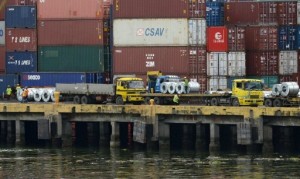PH seen posting trade surplus in 2015

The Philippines may chalk up this 2015 its first annual trade surplus in more than two decades of as much as $5 billion due to the combination of robust exports and a lower oil import bill. AFP FILE PHOTO
MANILA, Philippines–The Philippines may chalk up this 2015 its first annual trade surplus in more than two decades of as much as $5 billion due to the combination of robust exports and a lower oil import bill.
In a research note, JP Morgan’s chief economist for Southeast Asia Sin Beng Ong said the Philippines might end this year with a trade surplus of between $3 billion and $5 billion, marking the country’s first annual surplus since the late 1990s.
Ong based his projection on the pace of export earnings growth seen in the fourth quarter of 2014 alongside the downturn in oil prices.
“The oil price drop alone is expected to see oil imports decline by $5-$6 billion while exports have continued to expand solidly,” Ong pointed out.
Based on the latest official data, the Philippine trade balance incurred a small deficit of $68 million in December 2014. Seasonally adjusted balance posted a trade surplus of $330 million.
For 2014, the Philippine trade deficit narrowed to $2.1 billion or less than half the shortfall of $5.7 billion in 2013 and $10 billion in 2012.
Ong pointed out that export earnings have been notably robust even as imports slowed in the fourth quarter of 2014 due to lower capital goods imports and softer commodity prices. This favorable trend is seen to continue in 2015.
The trade surplus is seen boosting the country’s overall balance-of-payments surplus, which, in turn, would support a strong local currency and higher foreign exchange reserves by the Bangko Sentral ng Pilipinas (BSP), Ong said.
“In the interim, the BSP’s reaction to a strengthening effective exchange rate has been muted but this could change should the NEER (nominal effective exchange rate) continue to strengthen,” Ong said.
Ong noted that the BSP’s foreign exchange reserves had indeed risen in January by $1.2 billion to $80.7 billion.
